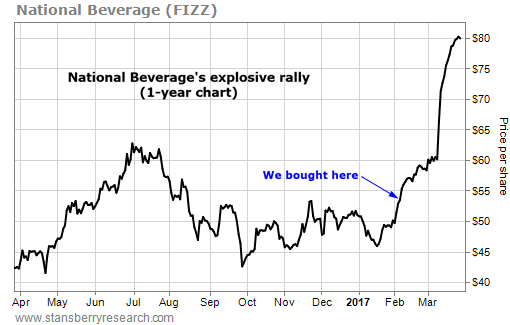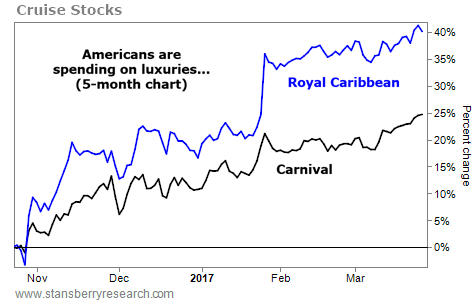| Home | About Us | Resources | Archive | Free Reports | Market Window |
Use This Little-Known Number to Find Explosive StocksBy
Tuesday, March 28, 2017
Lots of traders don't know anything about it...
But you can look at a specific number for just about any stock you want to trade.
For most stocks, this number is insignificant. But when it's big enough, it can help you make a lot of money, very quickly.
It's one of the secrets behind our biggest winner so far this year in DailyWealth Trader (DWT)... a 52%-plus gain in less than eight weeks.
Today, we'll explain everything you need to know about this number. We'll explain what it is and why it's important... And we'll show you when to use it for the best shot at explosive gains.
Let's get started...
The number we're talking about is called "short interest." Short interest is the percentage of a company's tradeable shares that folks are holding short.
To break that down, when we say "tradeable shares," we're not talking about the total number of shares outstanding. Usually, insiders or major stockholders stash some percentage of shares away for the long term... So they don't circulate regularly. All the other shares that do circulate are available for trading. The number of these tradeable shares is called a stock's "float."
If you're familiar with short selling, you may already understand what we mean by "holding short." If not, short selling (or simply, "shorting") is a type of trade that allows you to profit from stocks as they fall. It's the opposite of buying a stock.
Here's how it works... When you place the order, your broker lends you shares and sells them in the open market. You get the cash from the sale.
Then at some point in the future, you need to repay the loan... You need to buy those shares and return them to your broker. (This is called "covering" your short.) If you pay more than you earned from the original sale, you take a loss on the trade. If you can buy the shares back for less, you keep the difference and profit.
So again, short interest is the percentage of a stock's float that traders have sold – and are holding – short.
To understand why short interest is important, let's think about how the stock market works...
When a stock rises, it means that the demand for shares is greater than the desire to sell shares. Folks may not want to sell their shares at $20... But they may be willing to sell at $21. If the buyers are eager enough, they'll pay up... And the share price rises.
Normally, the folks that are thinking about buying a stock don't have to buy. They can hold on to their cash and wait patiently for the right price... Or they can simply move on, and never buy.
That's not the case with short sellers. Short sellers must buy shares to close out of their positions. And if the stock they're holding short is rising, their losses are growing.
At some point, they're going to jump out of the burning building. Remember, a stock can only go down so far. But there's no limit to how much it can go up... especially if nobody is eager to sell their shares.
Short sellers often choose to cut their losses at a time when shareholders don't really want to sell. Maybe the company just released great earnings results, for example, and said its future prospects are good.
Whatever the reason, short sellers need to buy shares to get out of their losing positions. But if nobody wants to sell shares to them, they're stuck in the position. So they're forced to offer to buy at higher and higher prices until they can finally get out of the trade.
If the short interest is high enough, the stock can explode higher. Traders call this a "short squeeze."
If you have ever been on the wrong side of a short squeeze, you know it's painful. If you're on the right side, though – if you're a shareholder – it's a lot of fun...
For instance, take what happened recently in DWT when we bought shares of sparkling-water and soft-drink producer National Beverage (FIZZ). It's our biggest winner so far this year...
At the time of our recommendation, National Beverage's short interest stood at about 20%. Anything over 15% is a lot. So 20% is extreme...
To give that some context, short sellers were holding 2.3 million shares short when the average number of shares traded in a day was just 233,000 (over the prior 30 days). In other words, if all the short sellers wanted to close out of their positions, it would take them 10 days of normal trading to cover their shares.
This figure – the "days to cover" – can give you an idea of how big a short squeeze might be. Once you get past four or five days to cover, you have the potential for an explosive move.
We're making money on National Beverage because it's a great business, we bought it at a fair price, and the stock market is moving higher. But we're up more than 52% in less than eight weeks because of the massive short squeeze...
 On March 9, National Beverage reported that its earnings per share for the quarter were up 117% from the same quarter a year earlier. If you were holding National Beverage short, that is not the report you were hoping for. Shares rocketed higher as short sellers scrambled to get out.
To be clear, we do not recommend buying stocks just because they have a high short interest... When a lot of investors agree that a stock should fall, they often have good reasons. Some businesses have slowing sales or operate in dying industries (like newspapers or shopping malls). These companies can continue lower for years, and short interest has nothing to do with it.
But when you find a stock that you're already interested in buying, high short interest could be that final piece that gets you to pull the trigger. After all, it may take just one positive announcement to set off a big short squeeze... and lead you to explosive profits.
Good trading,
Ben Morris
Further Reading:
"Plan your trades. And trade your plans," Ben writes. In a recent essay, he explains how to determine the outlook for your trades, and how doing so can help you avoid a common losing behavior in the markets. Read more here: The Most Important Question You Need to Ask Yourself Today.
Recently, Dan Ferris shared another strategy to help you identify stocks poised for success. It's a secret he found in the pages of shareholder letters... one that helps you look at the stock market in a way most people don't. Learn more here: Three Clues for Finding Companies That Jump off the Page.
Market NotesANOTHER SIGN THINGS CAN'T BE ALL THAT BAD Today's chart suggests that while people are still cautious about the U.S. economy, things can't be all that bad...
Longtime readers know we like to check in on certain economic "bellwethers" from time to time. The share-price strength of industries like hotels, swimming pools, and credit cards tells us a lot about whether Americans are feeling flush with cash or tightening the reins.
And based on share prices of popular cruise lines Carnival (CCL) and Royal Caribbean Cruises (RCL), Americans are treating themselves.
As you can see from the following chart, Carnival and Royal Caribbean are breaking out. Both stocks are up more than 25% over the last five months. Carnival just hit its highest level in more than a decade, and Royal Caribbean is a chip shot away from a new multidecade high. While the "talking heads" remain fixated on the latest drama in the White House, if cruise lines are marching to new highs, it's a sign that things can't be all that bad...
 |
Recent Articles
|



